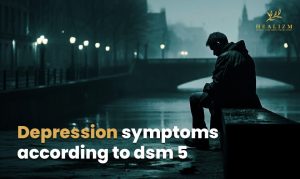
To determine mental health diagnoses, healthcare providers use the DSM-5.
The manual’s classification of depressive disorders has been updated with critical new guidelines.
It is a reference guide that healthcare and mental health professionals can use to better identify and diagnose issues related to mental health.
In this blog post, we’ll talk about the DSM-5, its purpose, and symptoms of depression.
Let’s dive in and discover new ways through Healizm!
What is DSM-5?
The “DSM,” is a reference book for mental health and brain-related situations and disorders.
American Psychiatric Association (APA) has written, edited, reviewed, and published the book.
The number “5” next to the name of the DSM denotes the fifth — and most recent — edition of this book.
in March 2022, APA published a revised sort of the fifth edition. The version is referred to as the DSM-5-TR™, with TR indicating “text revision.”
To know more about depressive disorder and its treatment, contact us!
What is the purpose of the DSM-5?
At the very first, you should diagnose it whether it is a mental condition or physical.
It gives clear, detailed definitions of mental health and disorders associated with the brain.
Furthermore, it also elaborates on the signs and symptoms of the situation that a victim faces.
In addition to defining and explaining illnesses, the DSM-5 classifies them.
By comparing similar conditions, it is easier for the mental health professional to identify the phase and current situation.
Depression Symptoms According To Dsm 5
Some symptoms of depression according to the DSM-5:
- Depressed mood
- Loss of interest or pleasure
- Significant weight loss or gain
- Sleep problems
- Fatigue
- Loss of energy
What is the diagnostic code for depression?
Diagnosis Code F32. 9: Unspecified single episode of major depressive disorder.
While clinicians typically bill their services under F32.9 for major depressive disorder, single episode, unspecified, the code may additionally describe the following:
- Unspecified depression (NOS).
- Depressive disorder, NOS.
- Major depression and NOS.
The first section of this code, F32, describes just one episode of major depressive disorder.
Emotional, mental, and neurodevelopmental conditions fall into the numeric range of.1 to 99.
What is F33 1 in the DSM-5?
Major Depressive Disorder (MDD), constant, moderate.
The diagnosis code for Major Depressive Disorder (MDD), Ongoing, Moderate is F33.1.
It is an illness characterized by persistently low mood, low self-esteem, and a loss of interest or pleasure in normally enjoyable activities.
The World Health Organization (WHO) developed this medical classification list, which is used to assist healthcare providers in identifying and coding health conditions.
Final Words
Approximately 21 million people are affected by the Major depressive disorder in the United States.
The DSM-5 is relied on by mental health professionals to make accurate and consistent diagnoses.
With the implementation of the DSM-5, some new classifications for depressive disorders were added, and current conditions were updated to reflect new research and scientific advances in mental health.
Seek guidance from a Mental health Professional by connecting with Healizm.
FAQ Section
What are the signs of despair according to the DSM-5?
There are a few symptoms of depression according to the DSM-5 that include:
- Loss of appetite
- Weight loss
- Insomnia
- Sleep apnea
- Depressed mood
What is the DSM-5 criteria code for depression?
f 32.9 as Major depressive disorder(MDD) is the criteria code for depression.
What are the DSM-5 severity levels for depression?
The DSM-5 does not specify the number of MDD symptoms required for each severity level, the following levels were established:
- Mild is 5 symptoms (the minimum for a diagnosis)
- Mild is 6 to 7 signs and symptoms
- Severe is 8 to 9 symptoms.
How is the DSM used to diagnose depression?
- Sadness,
- A bad attitude, and
- Loss of interest
These usual activities must indicate a departure from a person’s previous degree of functioning and last at least two weeks.
